As part of the USC Marshall Executive MBA program, I had the opportunity to travel through Vietnam and Singapore to meet with global business leaders, USC alumni, and expats shaping the future of work in Asia. While I’ve traveled internationally before, this wasn’t tourism. This was an immersive, professional deep dive – and it gave me a new perspective on life and business across the Pacific.
There is no better way to understand a country than to step into the environments where people work, lead, and innovate. This trip was exactly that – a rare, eye-opening glimpse into what it really looks like to live and lead abroad.
🇻🇳 Vietnam: Fast-Growth, Hard Reality
Our first day in Vietnam included a session with several expats who had moved to Vietnam to launch businesses – from an international marketing agency to a boutique investment firm. What stood out most was that these were Vietnamese-Americans who had grown up in the U.S. but chose to return and build something in their ancestral home. As someone who hopes to work abroad one day, this was an inspiring – and sometimes sobering – introduction.
One of our speakers was the son of a high-ranking North Vietnamese official who fled to the U.S. after the war. He had returned to Vietnam to buy and sell businesses, leveraging his father’s past connections. It was a reminder that while opportunity exists, it’s often wrapped in geopolitical complexity.
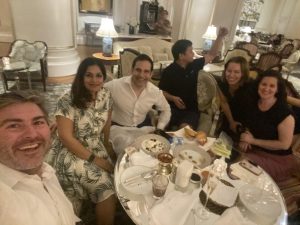
🧵 Avery Dennison: The Human Cost of Efficiency
Our next stop was a textile facility run by Avery Dennison – sleek, automated, and highly organized. We were told the conditions were excellent compared to other factories, and from what we saw, that held true. But then we learned the standard schedule: six 12-hour days a week, ramping to seven during peak production.
It raised a question I couldn’t shake: If this is what they’re willing to show us, what’s happening down the street?
While the work conditions were safe and systems modern, the sheer repetitiveness and intensity of the work – in silence, on machines, hour after hour – left me uneasy. It’s a stark reminder of the global engine of production we all rely on… and too often overlook.
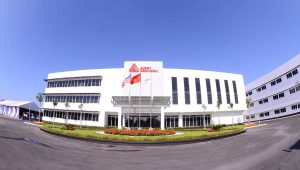

🕹 VNG Corporation: Vietnam’s Tech Titan
VNG was a stark contrast. This software and tech powerhouse operates with Silicon Valley flair – complete with a gym, lap pool, nap rooms, and multiple kitchens. We were hosted by a USC alum working as a director, a Vietnamese-American expat who didn’t speak Vietnamese, but led major product lines.
Their portfolio spans mobile games, a national social media platform, and a widely used payment app – all homegrown. The campus was designed to keep staff onsite, and it works. In Vietnam, where multi-generational households are the norm and young professionals often live with their families long into adulthood, these amenities offer a second home – but also blur the lines between life and labor.
To be clear: it was impressive. VNG offers prestige, great pay, and strong career paths. But it also left me reflecting on just how effective – and potentially exploitative – the “campus as home” model can be, especially in cultures where collectivism and career sacrifice run deep.
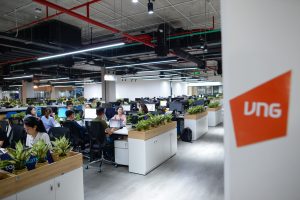
🇸🇬 Singapore: Corporate Precision and Controlled Perfection
If Vietnam felt fast and raw, Singapore was its controlled, polished sibling. Our first stop? Marina Bay Sands, hosted by a USC alumni executive who walked us through what might be the most jaw-dropping facility I’ve ever set foot in.
Everything – from the luxury suites (hidden ice machines and auto-warming coffee cups) to the retail corridors and art museums – was meticulous. The gambling floor, surprisingly discreet and tucked away, generates most of MBS’s revenue. Unlike American casinos, there was no neon-glitz lure – it was quietly elegant, sterile, and clean. In other words: quintessential Singapore.
Later, we heard from the Deputy CEO of Crypto.com, who explained how Singapore’s pro-crypto regulations made it an ideal home base. The country’s openness to innovation – when paired with its regulatory clarity – is rare and clearly attractive for emerging tech.
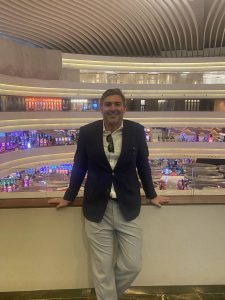
🎬 Inside Global Brands: Motion Picture Association & Johnson & Johnson
We were also fortunate to meet with leaders from the Motion Picture Association – Asia Pacific. The conversation revolved around content distribution, intellectual property enforcement, and the unique challenges of navigating censorship and cultural regulation across such a diverse region. It was a fascinating look into how global entertainment adapts and negotiates its place in complex political and legal landscapes.
At Johnson & Johnson International, we explored how the company structures its regional strategy. They discussed healthcare access in underserved areas, managing compliance across borders, and balancing global standards with local sensitivities – a true masterclass in multinational operations.
🏢 CapitaLand & Digiasia: Real People, Real Paths
Our final day brought us to CapitaLand and Digiasia, where we spoke to more expats and business leaders who had made the leap to living and working in Asia.
For someone like me – genuinely exploring the idea of bringing my family to Asia – their stories were invaluable. They were candid about the challenges, the culture shifts, and the long-game thinking it takes to build a career here. These weren’t fantasy expat dreams – they were real, actionable insights.
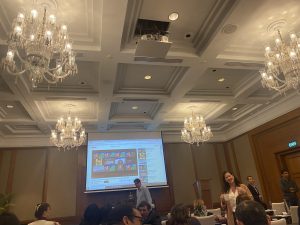
🧭 What I Learned: Global Business is Culture-First
There’s something both awe-inspiring and unnerving about Singapore’s extreme cleanliness, order, and control. On the surface, it feels perfect – like a model city. But it comes with hard lines. While there, we learned about a woman from the Philippines working at MBS who was deported for becoming pregnant while on a work visa – a technical violation, but one that highlighted how tightly Singapore guards its boundaries.
The businesses we met were equally polished – but always with a layer of control, intent, and optimization underneath. Efficiency is everything, but so is image.
🌏 Final Reflection
I’ve been to Asia before – Thailand, South Korea – but this trip gave me something far deeper: a sense of what it really means to live and work in these places. Not just to visit, not just to imagine – but to truly understand.
It’s easy to say “I’d love to live here” after a great vacation. It’s something else entirely to say that after walking factory floors, meeting global leaders, and hearing the real stories of expats navigating immigration, bureaucracy, and culture every day.
Could I live in Singapore? Without a doubt. Could I afford it? That’s another conversation. But one thing is certain: this trip changed my perspective – not just on Asia, but on my own path forward.
